Table of contents
1. Nacos configuration management
1.1. Unified configuration management
1.1.1. Add configuration files in nacos
1.1.2. Pull configuration from microservice
1) Add an environment sharing configuration
2) Read shared configuration in user-service
3) Run two UserApplications, using different profiles
4) Configure the priority of sharing
1.4.1. Cluster structure diagram
1. Nacos configuration management
In addition to being a registration center, Nacos can also be used for configuration management.
1.1. Unified configuration management
When more and more instances of microservices are deployed, reaching dozens or hundreds, modifying the configuration of microservices one by one will make people crazy and error-prone. We need a unified configuration management solution that can centrally manage the configuration of all instances.

On the one hand, Nacos can centrally manage the configuration, and on the other hand, when the configuration changes, it can notify the microservice in time to realize hot update of the configuration.
1.1.1. Add configuration files in nacos
How to manage configuration in nacos?

Then fill in the configuration information in the pop-up form

pattern:
dateformat: yyyy-MM-dd HH:mm:ssNote: The core configuration of the project needs to be managed by nacos only when the hot update configuration is required. It is better to save some configurations that will not be changed locally in the microservice.
1.1.2. Pull configuration from microservice
The microservice needs to pull the configuration managed in nacos and merge it with the local application.yml configuration to complete the project startup.
But if application.yml has not been read yet, how do you know the address of nacos?
Therefore, spring introduces a new configuration file: bootstrap.yaml file, which will be read before application.yml. The process is as follows:

1) Introduce nacos-config dependency
First, in the user-service service, introduce the client dependency of nacos-config:
<!--nacos配置管理依赖-->
<dependency>
<groupId>com.alibaba.cloud</groupId>
<artifactId>spring-cloud-starter-alibaba-nacos-config</artifactId>
</dependency>2) Add bootstrap.yaml
Then, add a bootstrap.yaml file in user-service with the following content:
spring:
application:
name: userservice # 服务名称
profiles:
active: dev #开发环境,这里是dev
cloud:
nacos:
server-addr: localhost:8848 # Nacos地址
config:
file-extension: yaml # 文件后缀名Here, the nacos address will be obtained according to spring.cloud.nacos.server-addr, and then according to
${spring.application.name}-${spring.profiles.active}.${spring.cloud.nacos.config.file-extension} is used as the file id to read the configuration.
In this example, it is to read userservice-dev.yaml:

3) Read nacos configuration
Add business logic to UserController in user-service, read pattern.dateformat configuration:

Full code:
package cn.itcast.user.web;
import cn.itcast.user.pojo.User;
import cn.itcast.user.service.UserService;
import lombok.extern.slf4j.Slf4j;
import org.springframework.beans.factory.annotation.Autowired;
import org.springframework.beans.factory.annotation.Value;
import org.springframework.boot.context.properties.ConfigurationProperties;
import org.springframework.cloud.context.config.annotation.RefreshScope;
import org.springframework.web.bind.annotation.*;
import java.time.LocalDateTime;
import java.time.format.DateTimeFormatter;
@Slf4j
@RestController
@RequestMapping("/user")
public class UserController {
@Autowired
private UserService userService;
@Value("${pattern.dateformat}")
private String dateformat;
/**
* 路径: /user/110
*
* @param id 用户id
* @return 用户
*/
@GetMapping("/{id}")
public User queryById(@PathVariable("id") Long id) {
return userService.queryById(id);
}
@GetMapping("/now")
public String now(){
return LocalDateTime.now().format(DateTimeFormatter.ofPattern(dateformat));
}
}When visiting the page, you can see the effect:

1.2. Configure hot update
Our ultimate goal is to modify the configuration in nacos, so that the microservice can make the configuration take effect without restarting, that is, configuration hot update .
To achieve configuration hot update, two methods can be used:
1.2.1. Method 1
Add the annotation @RefreshScope to the class where the variable injected by @Value is located:

1.2.2. Method 2
Use the @ConfigurationProperties annotation instead of the @Value annotation.
In the user-service service, add a class to read the patternern.dateformat property:
package cn.itcast.user.config;
import lombok.Data;
import org.springframework.boot.context.properties.ConfigurationProperties;
import org.springframework.stereotype.Component;
@Component
@Data
@ConfigurationProperties(prefix = "pattern")
public class PatternProperties {
private String dateformat;
}Use this class instead of @Value in UserController:
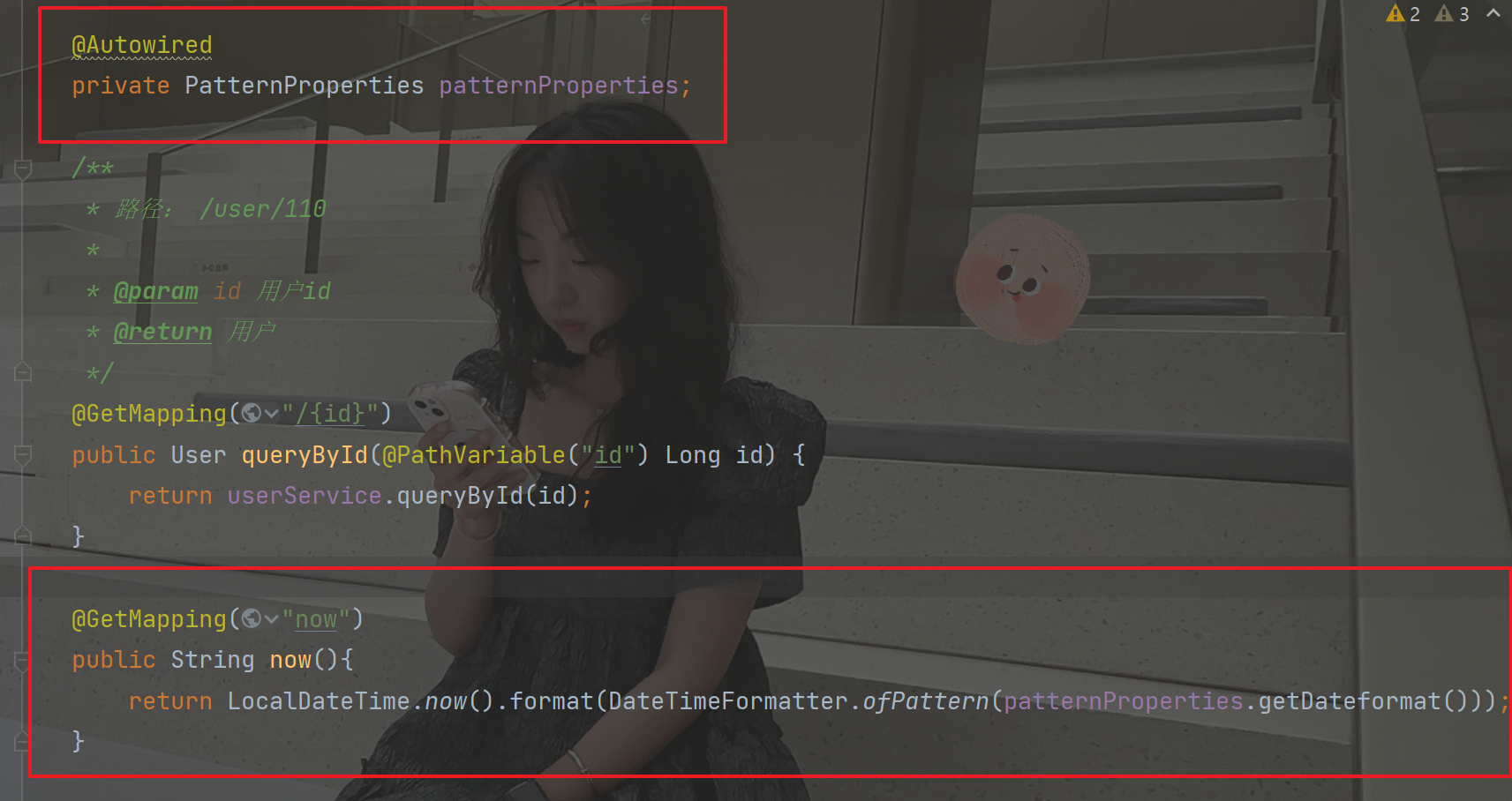
Full code:
package cn.itcast.user.web;
import cn.itcast.user.config.PatternProperties;
import cn.itcast.user.pojo.User;
import cn.itcast.user.service.UserService;
import lombok.extern.slf4j.Slf4j;
import org.springframework.beans.factory.annotation.Autowired;
import org.springframework.beans.factory.annotation.Value;
import org.springframework.cloud.context.config.annotation.RefreshScope;
import org.springframework.web.bind.annotation.*;
import java.time.LocalDateTime;
import java.time.format.DateTimeFormatter;
@Slf4j
@RestController
@RequestMapping("/user")
//@RefreshScope
public class UserController {
@Autowired
private UserService userService;
// @Value("${pattern.dateformat}")
// private String dateformat;
@Autowired
private PatternProperties patternProperties;
/**
* 路径: /user/110
*
* @param id 用户id
* @return 用户
*/
@GetMapping("/{id}")
public User queryById(@PathVariable("id") Long id) {
return userService.queryById(id);
}
@GetMapping("now")
public String now(){
return LocalDateTime.now().format(DateTimeFormatter.ofPattern(patternProperties.getDateformat()));
}
}1.3. Configuration Sharing
In fact, when the microservice starts, it will go to nacos to read multiple configuration files, for example:
- [spring.application.name]-[spring.profiles.active].yaml,例如:userservice-dev.yaml
- [spring.application.name].yaml,例如:userservice.yaml
And [spring.application.name].yaml does not contain the environment, so it can be shared by multiple environments.
Let's test the configuration sharing through the case
1) Add an environment sharing configuration
We add a userservice.yaml file in nacos:

2) Read shared configuration in user-service
In the user-service service, modify the PatternProperties class to read the newly added properties:

In the user-service service, modify UserController and add a method:

3) Run two UserApplications, using different profiles
Modify the startup item UserApplication2 and change its profile value:

In this way, the profile used by UserApplication (8081) is dev, and the profile used by UserApplication2 (8082) is test.
Start UserApplication and UserApplication2
Visit http://localhost:8081/user/prop , the result:

Visit http://localhost:8082/user/prop , the result:

It can be seen that both the dev and test environments have read the value of the attribute envSharedValue.
4) Configure the priority of sharing
When nacos and service local have the same attribute at the same time, the priority is divided into high and low:
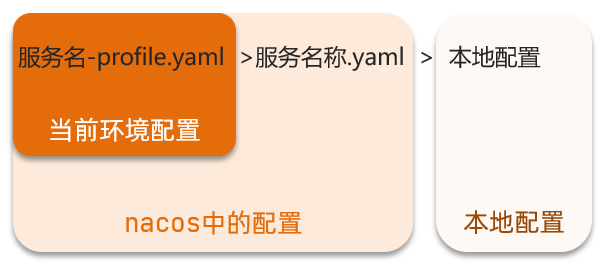
1.4. Build Nacos cluster
1.4.1. Cluster structure diagram
The official Nacos cluster diagram:
It contains 3 nacos nodes, and then a load balancer proxy 3 Nacos. Here the load balancer can use nginx.
Our planned cluster structure:
Addresses of three nacos nodes:
| node |
ip |
port |
| nacos1 |
192.168.150.1 |
8845 |
| nacos2 |
192.168.150.1 |
8846 |
| nacos3 |
192.168.150.1 |
8847 |
The IP here is the IP of your own service, not necessarily according to mine
1.4.2. Building a cluster
The basic steps to build a cluster:
- Build the database and initialize the database table structure
- Download nacos installation package
- configure nacos
- Start nacos cluster
- nginx reverse proxy
2.1. Initialize the database
Nacos default data is stored in the embedded database Derby, which is not a production-available database.
The officially recommended best practice is to use a high-availability database cluster with master-slave mode. For a high-availability database with master-slave mode, you can refer to the follow-up master courses of Chuanzhi Education .
Here we take a single-point database as an example to explain.
First create a new database, name it nacos, and then import the following SQL:
CREATE TABLE `config_info` (
`id` bigint(20) NOT NULL AUTO_INCREMENT COMMENT 'id',
`data_id` varchar(255) NOT NULL COMMENT 'data_id',
`group_id` varchar(255) DEFAULT NULL,
`content` longtext NOT NULL COMMENT 'content',
`md5` varchar(32) DEFAULT NULL COMMENT 'md5',
`gmt_create` datetime NOT NULL DEFAULT CURRENT_TIMESTAMP COMMENT '创建时间',
`gmt_modified` datetime NOT NULL DEFAULT CURRENT_TIMESTAMP COMMENT '修改时间',
`src_user` text COMMENT 'source user',
`src_ip` varchar(50) DEFAULT NULL COMMENT 'source ip',
`app_name` varchar(128) DEFAULT NULL,
`tenant_id` varchar(128) DEFAULT '' COMMENT '租户字段',
`c_desc` varchar(256) DEFAULT NULL,
`c_use` varchar(64) DEFAULT NULL,
`effect` varchar(64) DEFAULT NULL,
`type` varchar(64) DEFAULT NULL,
`c_schema` text,
PRIMARY KEY (`id`),
UNIQUE KEY `uk_configinfo_datagrouptenant` (`data_id`,`group_id`,`tenant_id`)
) ENGINE=InnoDB DEFAULT CHARSET=utf8 COLLATE=utf8_bin COMMENT='config_info';
/******************************************/
/* 数据库全名 = nacos_config */
/* 表名称 = config_info_aggr */
/******************************************/
CREATE TABLE `config_info_aggr` (
`id` bigint(20) NOT NULL AUTO_INCREMENT COMMENT 'id',
`data_id` varchar(255) NOT NULL COMMENT 'data_id',
`group_id` varchar(255) NOT NULL COMMENT 'group_id',
`datum_id` varchar(255) NOT NULL COMMENT 'datum_id',
`content` longtext NOT NULL COMMENT '内容',
`gmt_modified` datetime NOT NULL COMMENT '修改时间',
`app_name` varchar(128) DEFAULT NULL,
`tenant_id` varchar(128) DEFAULT '' COMMENT '租户字段',
PRIMARY KEY (`id`),
UNIQUE KEY `uk_configinfoaggr_datagrouptenantdatum` (`data_id`,`group_id`,`tenant_id`,`datum_id`)
) ENGINE=InnoDB DEFAULT CHARSET=utf8 COLLATE=utf8_bin COMMENT='增加租户字段';
/******************************************/
/* 数据库全名 = nacos_config */
/* 表名称 = config_info_beta */
/******************************************/
CREATE TABLE `config_info_beta` (
`id` bigint(20) NOT NULL AUTO_INCREMENT COMMENT 'id',
`data_id` varchar(255) NOT NULL COMMENT 'data_id',
`group_id` varchar(128) NOT NULL COMMENT 'group_id',
`app_name` varchar(128) DEFAULT NULL COMMENT 'app_name',
`content` longtext NOT NULL COMMENT 'content',
`beta_ips` varchar(1024) DEFAULT NULL COMMENT 'betaIps',
`md5` varchar(32) DEFAULT NULL COMMENT 'md5',
`gmt_create` datetime NOT NULL DEFAULT CURRENT_TIMESTAMP COMMENT '创建时间',
`gmt_modified` datetime NOT NULL DEFAULT CURRENT_TIMESTAMP COMMENT '修改时间',
`src_user` text COMMENT 'source user',
`src_ip` varchar(50) DEFAULT NULL COMMENT 'source ip',
`tenant_id` varchar(128) DEFAULT '' COMMENT '租户字段',
PRIMARY KEY (`id`),
UNIQUE KEY `uk_configinfobeta_datagrouptenant` (`data_id`,`group_id`,`tenant_id`)
) ENGINE=InnoDB DEFAULT CHARSET=utf8 COLLATE=utf8_bin COMMENT='config_info_beta';
/******************************************/
/* 数据库全名 = nacos_config */
/* 表名称 = config_info_tag */
/******************************************/
CREATE TABLE `config_info_tag` (
`id` bigint(20) NOT NULL AUTO_INCREMENT COMMENT 'id',
`data_id` varchar(255) NOT NULL COMMENT 'data_id',
`group_id` varchar(128) NOT NULL COMMENT 'group_id',
`tenant_id` varchar(128) DEFAULT '' COMMENT 'tenant_id',
`tag_id` varchar(128) NOT NULL COMMENT 'tag_id',
`app_name` varchar(128) DEFAULT NULL COMMENT 'app_name',
`content` longtext NOT NULL COMMENT 'content',
`md5` varchar(32) DEFAULT NULL COMMENT 'md5',
`gmt_create` datetime NOT NULL DEFAULT CURRENT_TIMESTAMP COMMENT '创建时间',
`gmt_modified` datetime NOT NULL DEFAULT CURRENT_TIMESTAMP COMMENT '修改时间',
`src_user` text COMMENT 'source user',
`src_ip` varchar(50) DEFAULT NULL COMMENT 'source ip',
PRIMARY KEY (`id`),
UNIQUE KEY `uk_configinfotag_datagrouptenanttag` (`data_id`,`group_id`,`tenant_id`,`tag_id`)
) ENGINE=InnoDB DEFAULT CHARSET=utf8 COLLATE=utf8_bin COMMENT='config_info_tag';
/******************************************/
/* 数据库全名 = nacos_config */
/* 表名称 = config_tags_relation */
/******************************************/
CREATE TABLE `config_tags_relation` (
`id` bigint(20) NOT NULL COMMENT 'id',
`tag_name` varchar(128) NOT NULL COMMENT 'tag_name',
`tag_type` varchar(64) DEFAULT NULL COMMENT 'tag_type',
`data_id` varchar(255) NOT NULL COMMENT 'data_id',
`group_id` varchar(128) NOT NULL COMMENT 'group_id',
`tenant_id` varchar(128) DEFAULT '' COMMENT 'tenant_id',
`nid` bigint(20) NOT NULL AUTO_INCREMENT,
PRIMARY KEY (`nid`),
UNIQUE KEY `uk_configtagrelation_configidtag` (`id`,`tag_name`,`tag_type`),
KEY `idx_tenant_id` (`tenant_id`)
) ENGINE=InnoDB DEFAULT CHARSET=utf8 COLLATE=utf8_bin COMMENT='config_tag_relation';
/******************************************/
/* 数据库全名 = nacos_config */
/* 表名称 = group_capacity */
/******************************************/
CREATE TABLE `group_capacity` (
`id` bigint(20) unsigned NOT NULL AUTO_INCREMENT COMMENT '主键ID',
`group_id` varchar(128) NOT NULL DEFAULT '' COMMENT 'Group ID,空字符表示整个集群',
`quota` int(10) unsigned NOT NULL DEFAULT '0' COMMENT '配额,0表示使用默认值',
`usage` int(10) unsigned NOT NULL DEFAULT '0' COMMENT '使用量',
`max_size` int(10) unsigned NOT NULL DEFAULT '0' COMMENT '单个配置大小上限,单位为字节,0表示使用默认值',
`max_aggr_count` int(10) unsigned NOT NULL DEFAULT '0' COMMENT '聚合子配置最大个数,,0表示使用默认值',
`max_aggr_size` int(10) unsigned NOT NULL DEFAULT '0' COMMENT '单个聚合数据的子配置大小上限,单位为字节,0表示使用默认值',
`max_history_count` int(10) unsigned NOT NULL DEFAULT '0' COMMENT '最大变更历史数量',
`gmt_create` datetime NOT NULL DEFAULT CURRENT_TIMESTAMP COMMENT '创建时间',
`gmt_modified` datetime NOT NULL DEFAULT CURRENT_TIMESTAMP COMMENT '修改时间',
PRIMARY KEY (`id`),
UNIQUE KEY `uk_group_id` (`group_id`)
) ENGINE=InnoDB DEFAULT CHARSET=utf8 COLLATE=utf8_bin COMMENT='集群、各Group容量信息表';
/******************************************/
/* 数据库全名 = nacos_config */
/* 表名称 = his_config_info */
/******************************************/
CREATE TABLE `his_config_info` (
`id` bigint(64) unsigned NOT NULL,
`nid` bigint(20) unsigned NOT NULL AUTO_INCREMENT,
`data_id` varchar(255) NOT NULL,
`group_id` varchar(128) NOT NULL,
`app_name` varchar(128) DEFAULT NULL COMMENT 'app_name',
`content` longtext NOT NULL,
`md5` varchar(32) DEFAULT NULL,
`gmt_create` datetime NOT NULL DEFAULT CURRENT_TIMESTAMP,
`gmt_modified` datetime NOT NULL DEFAULT CURRENT_TIMESTAMP,
`src_user` text,
`src_ip` varchar(50) DEFAULT NULL,
`op_type` char(10) DEFAULT NULL,
`tenant_id` varchar(128) DEFAULT '' COMMENT '租户字段',
PRIMARY KEY (`nid`),
KEY `idx_gmt_create` (`gmt_create`),
KEY `idx_gmt_modified` (`gmt_modified`),
KEY `idx_did` (`data_id`)
) ENGINE=InnoDB DEFAULT CHARSET=utf8 COLLATE=utf8_bin COMMENT='多租户改造';
/******************************************/
/* 数据库全名 = nacos_config */
/* 表名称 = tenant_capacity */
/******************************************/
CREATE TABLE `tenant_capacity` (
`id` bigint(20) unsigned NOT NULL AUTO_INCREMENT COMMENT '主键ID',
`tenant_id` varchar(128) NOT NULL DEFAULT '' COMMENT 'Tenant ID',
`quota` int(10) unsigned NOT NULL DEFAULT '0' COMMENT '配额,0表示使用默认值',
`usage` int(10) unsigned NOT NULL DEFAULT '0' COMMENT '使用量',
`max_size` int(10) unsigned NOT NULL DEFAULT '0' COMMENT '单个配置大小上限,单位为字节,0表示使用默认值',
`max_aggr_count` int(10) unsigned NOT NULL DEFAULT '0' COMMENT '聚合子配置最大个数',
`max_aggr_size` int(10) unsigned NOT NULL DEFAULT '0' COMMENT '单个聚合数据的子配置大小上限,单位为字节,0表示使用默认值',
`max_history_count` int(10) unsigned NOT NULL DEFAULT '0' COMMENT '最大变更历史数量',
`gmt_create` datetime NOT NULL DEFAULT CURRENT_TIMESTAMP COMMENT '创建时间',
`gmt_modified` datetime NOT NULL DEFAULT CURRENT_TIMESTAMP COMMENT '修改时间',
PRIMARY KEY (`id`),
UNIQUE KEY `uk_tenant_id` (`tenant_id`)
) ENGINE=InnoDB DEFAULT CHARSET=utf8 COLLATE=utf8_bin COMMENT='租户容量信息表';
CREATE TABLE `tenant_info` (
`id` bigint(20) NOT NULL AUTO_INCREMENT COMMENT 'id',
`kp` varchar(128) NOT NULL COMMENT 'kp',
`tenant_id` varchar(128) default '' COMMENT 'tenant_id',
`tenant_name` varchar(128) default '' COMMENT 'tenant_name',
`tenant_desc` varchar(256) DEFAULT NULL COMMENT 'tenant_desc',
`create_source` varchar(32) DEFAULT NULL COMMENT 'create_source',
`gmt_create` bigint(20) NOT NULL COMMENT '创建时间',
`gmt_modified` bigint(20) NOT NULL COMMENT '修改时间',
PRIMARY KEY (`id`),
UNIQUE KEY `uk_tenant_info_kptenantid` (`kp`,`tenant_id`),
KEY `idx_tenant_id` (`tenant_id`)
) ENGINE=InnoDB DEFAULT CHARSET=utf8 COLLATE=utf8_bin COMMENT='tenant_info';
CREATE TABLE `users` (
`username` varchar(50) NOT NULL PRIMARY KEY,
`password` varchar(500) NOT NULL,
`enabled` boolean NOT NULL
);
CREATE TABLE `roles` (
`username` varchar(50) NOT NULL,
`role` varchar(50) NOT NULL,
UNIQUE INDEX `idx_user_role` (`username` ASC, `role` ASC) USING BTREE
);
CREATE TABLE `permissions` (
`role` varchar(50) NOT NULL,
`resource` varchar(255) NOT NULL,
`action` varchar(8) NOT NULL,
UNIQUE INDEX `uk_role_permission` (`role`,`resource`,`action`) USING BTREE
);
INSERT INTO users (username, password, enabled) VALUES ('nacos', '$2a$10$EuWPZHzz32dJN7jexM34MOeYirDdFAZm2kuWj7VEOJhhZkDrxfvUu', TRUE);
INSERT INTO roles (username, role) VALUES ('nacos', 'ROLE_ADMIN');2.2. Download nacos
nacos has a download address on GitHub: Tags · alibaba/nacos · GitHub , you can choose any version to download.
Only version 1.4.1 is used in this example:

2.3. Configure Nacos
Unzip this package to any non-Chinese directory, as shown in the figure:

Directory description:
- bin: startup script
- conf: configuration file
Enter the conf directory of nacos, modify the configuration file cluster.conf.example, and rename it to cluster.conf:
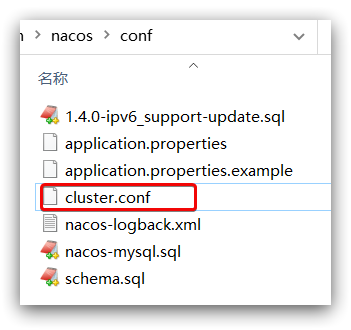
Then add content:
127.0.0.1:8845 127.0.0.1:8846 127.0.0.1:8847
Note: The IP here is the IP of your own service, not necessarily according to mine!
When a single node is running, you can go to the nacos console to view your own node IP, then configure the same IP here:
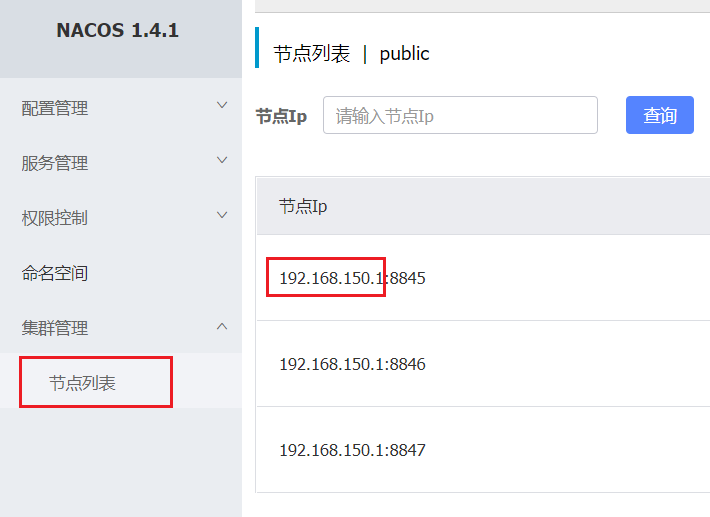
Then modify the application.properties file and add the database configuration
### Specify local server's IP:
nacos.inetutils.ip-address=127.0.0.1
spring.datasource.platform=mysql
db.num=1
db.url.0=jdbc:mysql://127.0.0.1:3306/nacos?characterEncoding=utf8&connectTimeout=1000&socketTimeout=3000&autoReconnect=true&useUnicode=true&useSSL=false&serverTimezone=UTC
db.user.0=root
db.password.0=rootPlease configure the database address, user name, and password here according to the actual situation.
2.4. Startup
Copy the nacos folder three times and name them: nacos1, nacos2, nacos3

Then modify the application.properties in the three folders respectively,
nacos1:
server.port=8845
nacos2:
server.port=8846
nacos3:
server.port=8847
Then start three nacos nodes respectively:
startup.cmd
2.5.nginx reverse proxy
Find the nginx installation package provided by the pre-class materials:

Unzip to any non-Chinese directory:
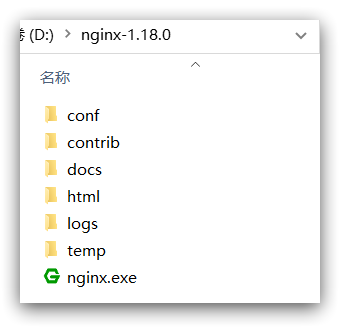
Modify the conf/nginx.conf file, the configuration is as follows:
worker_processes 1;
events {
worker_connections 1024;
}
http {
include mime.types;
default_type application/octet-stream;
sendfile on;
keepalive_timeout 65;
upstream nacos-cluster {
server 127.0.0.1:8845;
server 127.0.0.1:8846;
server 127.0.0.1:8847;
}
server {
listen 80;
server_name localhost;
location /nacos {
proxy_pass http://nacos-cluster;
}
}
}Then visit in the browser: http://localhost/nacos .
The application.yml file configuration in the code is as follows:
spring:
cloud:
nacos:
server-addr: localhost:80 # Nacos地址2.6. Optimization
- In actual deployment, it is necessary to set a domain name for the nginx server that acts as a reverse proxy, so that there is no need to change the configuration of the nacos client if the server is migrated later.
- Each node of Nacos should be deployed to multiple different servers for disaster recovery and isolation